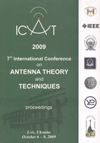Bearing estimation of a source with complicated spectrum using a moving sparse antenna array
DOI:
https://doi.org/10.1109/ICATT.2009.4435137Keywords:
acoustic array systems and processing, aperture synthesis and source localization, sparse antenna arrayAbstract
Estimation of bearing of a narrowband source with the use of a sparse equidistant array usually turns out to be ambiguous. For a wideband source with smooth spectrum, this ambiguity can be overcome at the expense of decreasing the spatial resolution. At the same time, the ambiguity of bearing estimate of a narrowband source can be eliminated if the array is moving in respect to the source, and the well-known technique used in radars and sonars with synthetic aperture is used (in this case, a single receiver is enough). In the present article, a scenario is analyzed when the source spectrum has a smooth wideband component and several narrowband components; such a spectrum is typical, for example, for underwater noise of ships. It is shown that a procedure of aperture synthesis applied to such a signal gives, under some conditions, the same result as conventional beamforming using a motionless array. This fact allows for effective separation of discrete components of the spectrum from its continuous part. Estimates of aperture synthesis duration allowing one to perform such a separation, as well as output signal-to-noise ratios, are presented.References
VAN TREES, H.L. Detection, Estimation, and Modulation Theory, Part IV, Optimum Array Processing. New York: Wiley, 2002.
URICK, R.J. Principles of Underwater Sound. New York: McGraw-Hill, 1983.
KIM, K.H.; HURSKY, P.; PORTER, M.B.; HILDEBRAND, J.A.; HENDERSON, E.E.; WIGGINS, S.M. Automated passive acoustic tracking of dolphins in free-ranging pods. Proc. of 8th ECUA, Carvoerio, 2006, p.329-334.
Published
2009-10-10
Issue
Section
Antenna arrays

